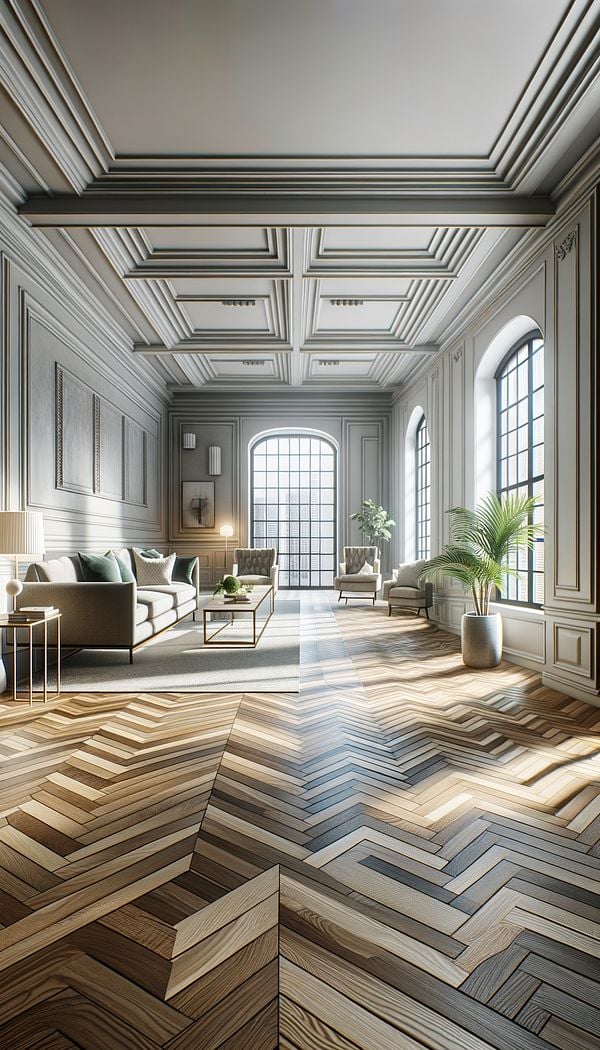What is Herringbone?
Herringbone refers to a distinctive V-shaped weaving or tiling pattern.
Description
Herringbone is a classic pattern in interior design that has been admired for centuries for its timeless beauty and dynamic visual appeal. This captivating V-shaped pattern resembles the skeleton of a herring fish, which is how it got its name. The pattern is created by arranging rectangles at a 45-degree angle to each other, forming a zigzag pattern that is symmetrical and efficient in its use of space.
The beauty of herringbone lies in its versatility. It can be applied in various design elements such as flooring, wall treatments, and fabric designs. In flooring, herringbone can elevate the look of hardwood, tile, or even vinyl, adding texture and dimension to a space. When used on walls, it can be a focal point or a subtle backdrop, depending on the material and color chosen. In textiles and upholstery, the herringbone pattern adds visual interest and sophistication.
Furthermore, the herringbone pattern transcends style boundaries, fitting seamlessly into contemporary, traditional, and rustic design schemes. Its intricate geometry can add movement and depth to any space, making it a beloved choice for designers looking to create an engaging and attractive interior.
Usage
A classic example of herringbone in use is herringbone wood flooring, which adds warmth and character to living spaces, studies, and hallways. It's also popular in bathroom tiling, where it can make a small space appear larger due to its dynamic pattern. Textiles such as throws and upholstery often feature the herringbone pattern for its sophisticated texture and aesthetic appeal.
FAQs
-
Is herringbone pattern the same as chevron?
No, herringbone and chevron are different patterns. Although they both consist of a V-shaped design, herringbone pieces are arranged in a broken zigzag manner, creating a more staggered appearance, whereas chevron pieces meet at a point creating a continuous straight line.
-
Can herringbone pattern be used in small spaces?
Yes, the herringbone pattern is suitable for small spaces as it can add depth and the illusion of a larger space, especially when used on floors or walls.
-
How does the herringbone pattern affect the feel of a room?
The herringbone pattern adds movement, depth, and sophistication to a room. It can make a space feel dynamic and elegant, and depending on the color and material used, it can also add warmth and character.
Practical Application
When incorporating herringbone into your design, consider the scale and color of the pattern in relation to the size of the room and its overall style. For flooring, using larger planks can make a small room appear larger, while smaller tiles can add more detailed texture. In textiles, the herringbone pattern adds a luxurious touch, so choose fabrics that complement the room’s color scheme and design style. Remember, herringbone can be a strong design element, so balance it with simpler shapes and colors elsewhere in the space.
-
Design Styles478 articles
-
Decorating Principles & Elements330 articles
-
Textiles & Upholstery252 articles
-
Flooring & Carpets48 articles
-
Wall Treatments & Finishes157 articles
-
Art PrintAn art print is a reproduction of an original work of art.
-
Goblet PleatA type of curtain heading that resembles the shape of a goblet.
-
CrockingCrocking refers to the rubbing off of color from one material onto another.
-
GroutGrout is a dense fluid used to fill and seal the joints between tiles.
-
TV ArmoireA tall, freestanding cabinet designed specifically to house a television and related media equipment.
